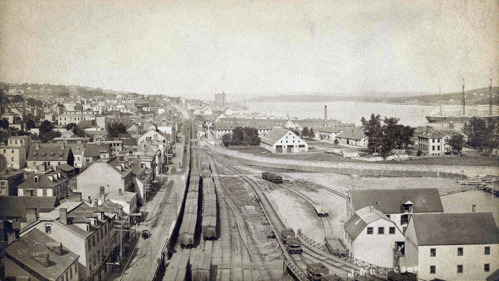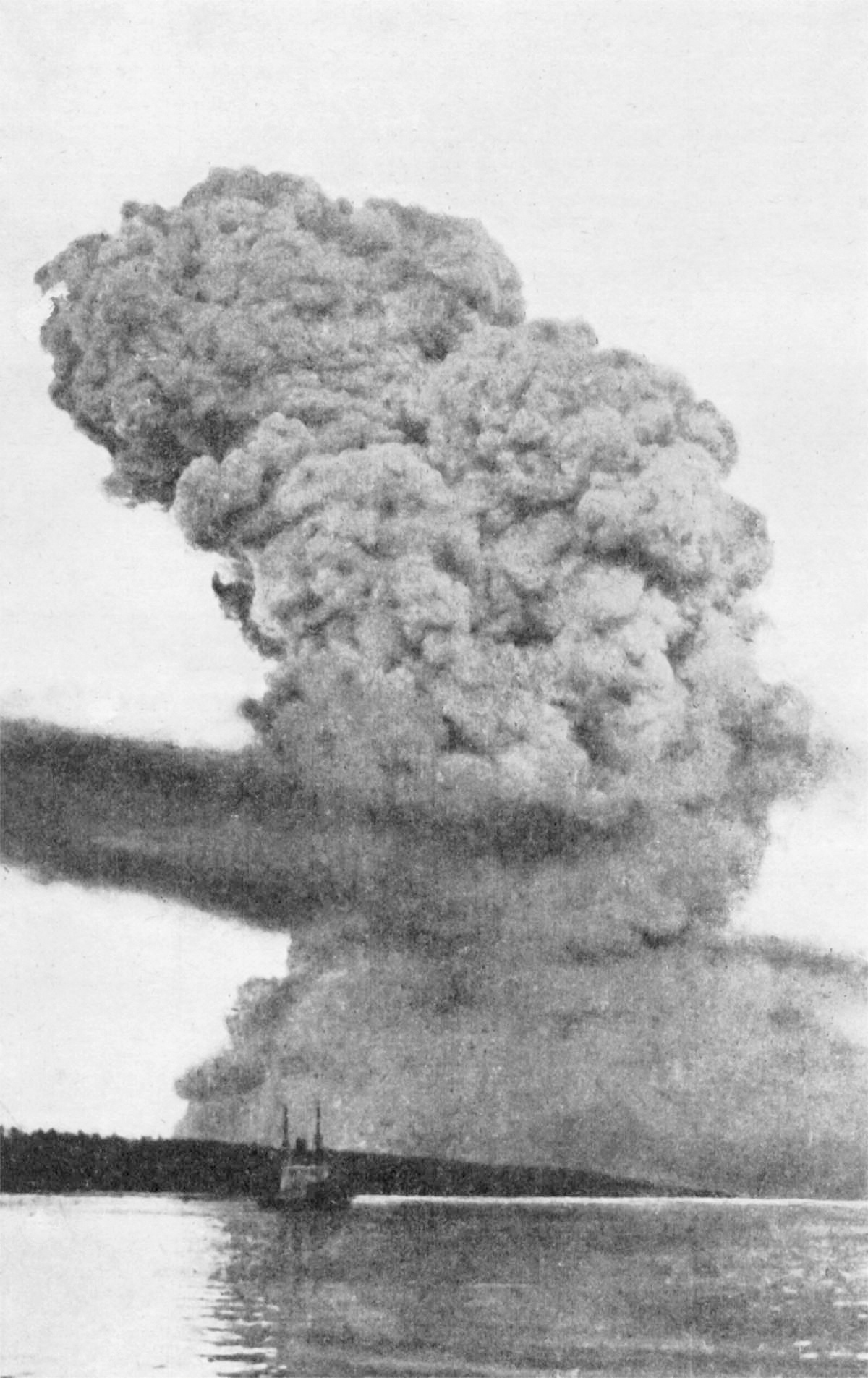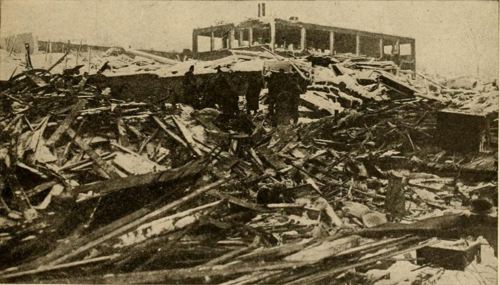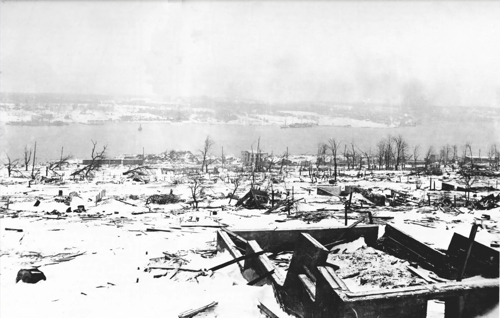06 December 2022
The Halifax Explosion 105 years on
On December 6th, 1917, what was then the most powerful manmade explosion the world had yet seen hit Halifax, Nova Scotia. This is the story of the Halifax explosion.
WHAT HAPPENED IN The Halifax Explosion?

Devastation at Halifax (© IWM Q 71058)
Where is Halifax?
Halifax is the primary port and capital of the Canadian province of Nova Scotia.
The Nova Scotia peninsula sits on Canada’s east coast, the cold, grey waters of the Atlantic Ocean lapping its shores. Halifax itself lies in eastern Nova Scotia at the mouth of a natural harbour.
Bedford Basin forms the north-western end of Halifax Harbour with towns and settlements scattered all around it. A thin strait called the Narrows feeds into Bedford Basin, separating it from the wild Atlantic.
Crucially, Halifax is an ice-free port and dock. Its waters don’t freeze even in the deepest of Canadian winters. Year-round operations are possible – a very attractive property for a North Atlantic port.
Across the bay from Halifax lies Dartmouth as well as small enclaves of native Mi’kmaq first nation people.
Halifax in World War One
 Image: Halifax around the time of World War One (Wikimedia Commons)
Image: Halifax around the time of World War One (Wikimedia Commons)
Halifax was a busy, thriving port in World War One. By 1917, it had become a key logistics node and base for Atlantic convoys.
Its pre-war population of 50,000 swelled as naval, army, and associated persons flocked to Halifax.
Millions of tons of cargo passed through Halifax during the war years. Wheat, coal, foodstuffs, and ammunition were funnelled into the port by Canada’s Intercontinental Railroad.
They were then placed aboard merchant vessels that braved stormy seas and predatory Imperial German submarines to ferry this much-needed materiel to Europe’s battlefields.
Halifax was also a troop embarkation point. Thousands of Canadian, Commonwealth and American service personnel passed through Halifax during the war, either on their way to fight or on their way home.
The Royal Canadian Navy was still finding its sea legs during World War One. It had yet to truly expand but its limited ships used Halifax as a base to patrol Canadian waters and aid transatlantic convoys.
Even so, the Royal Navy and the Admiralty effectively controlled Halifax and its dockyards. Royal Navy vessels were ever-present.
During this time, Halifax was a fortress. The waterside was bristling with gun emplacements and observation posts and the docks teeming with military personnel. Nets were carefully laid in the harbour entrance to ensnare any U-boats lurking sinisterly beneath the water.
These measures were usual for the protection of important dockyard and naval facilities. Halifax’s residents genuinely feared German attack, believing an enemy battleship or fleet may appear at any moment and start shelling the harbour.
We might think a German naval assault on such a port unlikely, given the sheer distance between North America and Europe, but for the people of Halifax, this was a real fear.
THE HALIFAX DISASTER - Explosion & devastation

The huge smoke cloud thrown up by the explosion. Note the vessel dwarfed by the sheer size of the plume (Wikimedia Commons).
At 9.04 am on 6th December 1917, Halifax was smashed by a terrific, devastating explosion.
The world had yet to experience an explosion of the magnitude that tore Halifax to pieces that fateful day.
It wouldn’t be until 1945 and the dropping of the Atomic Bombs on Hiroshima that a man-made detonation would exceed the force of the Halifax explosion.
It wasn’t just the concussive and explosive force that devastated Halifax. The explosion caused a tsunami to whip chaotically across the bay, adding to the massive damage the port and its surrounding settlements suffered.
The northern end of the port city was flattened by the blast and subsequent tsunami. Dartmouth across the bay was smashed too as was the nearby Mi’kmaq settlement.
Homes, churches, offices, warehouses and freight yards, ships, and rail infrastructure and carriages were all smashed with terrible, deadly force. The city became a mess of collapsing buildings. Fires quickly took hold. Buildings collapsed inward as flames licked and burned through supports and foundations.
The devastation was huge. Over CA$35,000,000 worth of damage had been caused or around CA$627,000,000 in today’s money.
Close to 2,000 people lost their lives. A further 9,000 were injured, maimed, or blinded. Over 25,000 people were left without homes or shelter.
Initially, the port’s residents feared the worst: the German Navy had arrived and was bombarding their beloved city.
But what’s the truth? How did this tragic explosion come to pass? Why was Halifax flattened? Let’s find out.
Countdown to collision

The highly damaged Imo lists on his side in Halifax Harbour (Wikimedia Commons)
While Bedford Basin is an open expanse and able to comfortably handle plenty of shipping, access to the Basin was restricted by the Narrows at the time of the explosion.
This aptly named stretch presented a squeeze for ships passing through. Coupled with the submarine nets, although these were gated to allow ships to make their way in and out of the harbour, ship speeds and timings were carefully monitored in Halifax Harbour so as to avoid congestion and collisions.
One of the merchant ships calling in at Halifax on December 6th, 1917, was the Imo, a Norwegian vessel on its way down to New York.
Imo’s mission was to pick up supplies to aid the beleaguered civilians of war-torn Belgium. Emblazoned on the ship’s side were the words “BELGIAN RELIEF” in a clear reminder of its purpose.
Joining Imo in Halifax that fateful day was the French munitions ship Mont-Blanc.
Mont-Blanc held a particularly deadly cargo. As a munitions ship, she was packed with high explosives and volatile substances like TNT, guncotton, picric acid and benzol.
Outside of wartime, munitions ships like Mont-Blanc were barred from entering Halifax. But with the Admiralty taking direct control of the port, they were allowed into Halifax Harbour’s inner reaches into Bedford Basin.
Imo was leaving the harbour out of Bedford Basin and was making its way through the Narrows. Unusually, she was sailing on the Narrows’ eastern side, closer to Dartmouth than Halifax.
Two inbound ships coming into the Basin had passed Imo earlier in the day. They each passed starboard to starboard, i.e., on each other’s right, which resulted in the Imo essentially being on the wrong side of the Narrows.
Two Ships Collide
 Image: Northern Halifax was completely flattened by the blast as a result of the two ships' collision (Wikimedia Commons).
Image: Northern Halifax was completely flattened by the blast as a result of the two ships' collision (Wikimedia Commons).
Meanwhile, Mont-Blanc and its dangerous cargo were making their way into Bedford Basin after anchoring overnight outside Halifax.
Despite the fact Mont-Blanc was laden with highly explosive material, there were no protocols dictating other ships to vacate the harbour or hold their positions until she had passed. Ships were able to come and go as they pleased within normal operating procedures.
Mont-Blanc was making its way up the Narrow’s eastern side. Directly ahead of her was the Imo.
According to Francis Mackey, the Mont-Blanc’s pilot who miraculously survived the explosion, Imo was a) in Mont-Blanc’s path and b) travelling at unsafe speeds.
Imo was considered a large, unwieldy vessel so may have been too fast for a ship of its size while Mackey maintained Mont-Blanc had right of way as an incoming vessel.
It’s the consensus of historians that, regardless of Mackey’s testimony, Imo was completely out of position.
Both crews frantically signalled and whistled at each other and took evasive manoeuvres, but it was soon clear the vessels were on a collision course.
Imo crashed into Mont-Blanc’s starboard bow, creating a gash in Mont-Blanc’s hull, generating sparks.
Those tiny sparks ignited the volatile picric acid. The ship burst into flame.
For 20 minutes, Mont-Blanc burned. As the fire engulfed the benzol on the ship’s top deck, plumes of acrid black smoke blossomed into the Halifax sky.
 Image: Halifax, Darthmouth and other settlements took terrible damage once Mont-Blanc exploded (Wikimedia Commons).
Image: Halifax, Darthmouth and other settlements took terrible damage once Mont-Blanc exploded (Wikimedia Commons).
A crowd of onlookers, including children on their way to school, dockworkers, and everyday civilians, lined the dockside. Lifeboats ferried Mackey and the Mont-Blanc’s crew tried desperately to escape their doomed vessel.
The burning, crippled Mont-Blanc drifted lazily toward Pier 6 on the Halifax side of Bedford Basin. Residential homes, businesses, moored vessels, a large sugar refinery and the Royal Navy College of Canada lay in its path.
At 09.04 am Mont-Blanc exploded.
Debris, shrapnel, and wholesale chunks of the munitions ship rained down in a deadly hail over Halifax. Vaporized chunks flew into the sky in a maelstrom of fire and smoke. Mont-Blanc’s anchor, weighing several tons, was blasted across the port and into the city, landing 4km away from the epicentre.
As for Imo, she was tossed as if she weighed nothing onto the Dartmouth shoreline, crashing down and causing havoc.
Alongside the falling scraps of hot metal, a black rain drifted over Halifax and its surrounding settlements as carbon particles fell from above.
Spectators, sailors, dockworkers, and others nearby were either killed by the blast wave, the obliterating tsunami or from being knocked sky high. Bodies were tossed and thrown like ragdolls.
HOW MANY DIED IN THE HALIFAX EXPLOSION?
As mentioned earlier, the death toll stretched into the thousands while tens of thousands were injured or left without homes or shelter.
DID ANY CREW MEMBERS SURVIVE THE HALIFAX EXPLOSION?
Surprisingly, given the size of the explosion, the crews of the Mont-Blanc and the Imo were relatively unscathed.
One sailor from Mont-Blanc, Yves Queguiner, died in the explosion, while the crew of the Imo sustained a handful more casualties.
Despite being at the very epicentre of the explosion, the Imo survived, was repaired and eventually re-floated in April 1918. The Mont-Blanc was not so lucky, all but disintegrating in the blast.
HOW BIG WAS THE HALIFAX EXPLOSION?
The Halifax explosion was equivalent to 2.9 kilotons of TNT.
Shockwaves were felt as far away as Cape Breton over 200km away.
Rescue attempts
While Mont-Blanc was aflame, several highly courageous teams of men, risking life and limb, made multiple attempts to rescue crew members from the burning vessel.
Smaller vessels and boats did their best to move the stricken munitions ship away from its final position, but despite their best efforts, the tragedy could not be avoided.
Many knew of the deadly cargo aboard the stricken ship making their sacrifice all the more incredible, inspirational, and humbling.
Able Seaman Albert Saunders
 Image: Albert Saunders, one of the many who gave their lives trying to dislodge Mont-Blanc
Image: Albert Saunders, one of the many who gave their lives trying to dislodge Mont-Blanc
Only a few short days before the disaster at Halifax, Albert Saunders had written to his mother. He was sharing the good news of his promotion to able seaman. It would be the last missive from her son Albert’s mother would ever receive.
Albert, Bert to his friends, had left his native Winnipeg to join the Royal Canadian Navy for roughly a year. At the time of the Halifax Explosion, Albert was serving aboard HMS Niobe.
Niobe, a repurposed British steamer was one of the first ships to respond to the Mont-Blanc. Albert was also one of the first to volunteer for the suicidal mission of attempting to move the beleaguered munitions ship and rescue its crew.
Albert and his comrades set out on a launch from the Niobe which drew alongside Mont-Blanc. As they were pulling alongside, the munitions triggered, engulfing the launch, and claiming the lives of all souls on board.
As nobody was found, Albert is commemorated on the Halifax (Fort Massey) Memorial.
Commander Thomas Kenneth Triggs
Southsea, UK-born naval officer Commander Thomas Kenneth Triggs is another whose self-sacrifice during the events of the Halifax Explosion deserves attention.
Commander Triggs and a small party set off from HMS Highflyer aboard a whaler, joining the number of small boats and vessels, including a tugboat, determined to drag the blazing Mont-Blanc off its beached position at Pier 6.
By this time, flames were licking through the ship. Triggs understood the severity of what could happen if the intense heat set off the explosive cargo in the ship’s hold.
Triggs boarded the tug, but the Commander realised there was nothing that could be done for Mont-Blanc. He directed the tug to focus on Imo instead, before returning to his whaler.
Tragically, Triggs and the Highflyer party were caught up in the blast. At the time Mont-Blanc went, Triggs and his whaler were about 300 yards away, pulling towards Imo's bows in order to pass a line from the Norwegian vessel to the tug.
The Commander’s body was never recovered. For his amazing bravery, Triggs was posthumously awarded the Albert Medal.
Commander Thomas Triggs is commemorated on the Portsmouth Naval Memorial.

Halifax (Fort Massey) holds several burials from the Halifax Explosion as well as the Halifax (Fort Massey) Memorial
WHO WAS AT FAULT FOR THE HALIFAX EXPLOSION?
Initially, many thought that the explosion was somehow caused by German agents, and the Norwegian helmsman of the Imo was questioned under the suspicion of being a spy.
On 13 December 1917, a legal enquiry into the cause of the disaster was begun, eventually releasing its report in February 1918, which blamed the captain of the Mont-Blanc, her pilot and the Commander in charge of the harbour’s defences as responsible for the collision.
Charges of manslaughter and criminal negglience were levied against the three men. Nova Scotia Supreme Court Justice Benjamin Russell found no evidence to support these claims.
Pilot Francis Mackey was given a writ of habeas corpus and charges dropped. As Captain Aimé Le Médec had been arrested on the same warrant as Mackey, the charges against him were dropped too.
Commander Wyatt, Royal Canadian Navy's chief examining officer in charge of the harbour, gates and anti-submarine defences, was the only man indicted. He was acquitted by jury in a trial lasting only a day.
After the war, the Supreme Court of Canada and the Judicial Committee of the Privy Council in London ruled that both the Mont-Blanc and the Imo were equally to blame for the collision.
Ultimately, no party was ever convicted for any crime or persecuted successfully for any actions leading up to the collision and explosion.
WHAT HAPPENED AFTER THE HALIFAX EXPLOSION?
The day after the explosion, Halifax was hit by a vicious snow storm, hampering rescue attempts and meaning that the thousands of people who had lost their homes in the blast suddenly had to fight for their lives, further adding to the death toll.
Relief was sent from across Canada and the northeastern United States, notably from Boston, Massachusetts, joining the first responders in fighting fires, rescuing trapped civilians and providing medical treatment.
As well as the large numbers of dead, there were an incredible number of injuries. The flying glass from the initial blast caused a significant number of eye injuries among those who had gathered to watch the blaze in the harbour.
HOW DID THE HALIFAX EXPLOSION AFFECT WW1?
While the explosion itself didn’t have a direct effect on the battlefronts in Europe, the explosion caused a lot of disruption of the communications in the North Atlantic.
The port and its immediate vicinity were devastated, severing the rail links and roadways that serviced the docks. Telephone lines and cables on the seafloor were also damaged, impacting transatlantic communications.
WHY IS THE HALIFAX EXPLOSION HISTORICALLY SIGNIFICANT?
The Halifax explosion remains the largest manmade, non-nuclear, explosion in history.
Its magnitude, the efforts of the emergency responders, and the long-term effects of the blast on Halifax itself have provided the backdrop to several films, books and television shows.
Today, more than 100 years after the explosion, Nova Scotia donates a Christmas tree to the city of Boston as a token of thanks for the help given in the aftermath of the blast.
REMEMBERING THE CASUALTIES AT HALIFAX CEMETERY
Several burials within the Halifax (Fort Massey) Cemetery are casualties of the Halifax Explosion.
During World War One, Halifax was part of Military District No.6. Several hospitals within the district cared for the wounded and victims of accidents and mishaps during training exercises and daily military life within Halifax.
The explosion ruined two hospitals and damaged a further medical facility. These casualties are today buried at Halifax (Fort Massey) Cemetery.
Within the grounds of the cemetery, you will find the Halifax (Fort Massey). This commemorates those lost with no known grave, including casualties from the disaster in Halifax Harbour.
Halifax (St John’s) Cemetery and Halifax (Mount Olivet) Cemetery also contain burials from the Halifax Explosion.
Discover more stories of the Commonwealth’s fallen
With our search tools, you can uncover more about the service men and women we commemorate in Canada and around the world.
Find War Dead gives you access to our whole database of Commonwealth casualties from both world wars. Search by name, unit, burial location and many more metrics to uncover more information.
You can also learn where those under our care are commemorated and how to visit them with our Find Cemeteries & Memorials tool.
What will your search uncover?

